You wouldn’t think it would be this hard, but I’m having a tough time finding a keyboard I like and realised the keyboard is possibly the most important part of a computer system, at least from an HCI perspective…
Back when I terrorised a very patient, kind, middle-aged man and the local populace of the South Manchester town I then lived in by learning to drive almost two decades ago (2006), said kind and patient driving instructor taught me many useful things that have stayed with me ever since. The concept of MSM: Mirror, Signal, Maneuver for one and the idea that your tyres are possibly the most important – and most overlooked – part of any car.
I was confused by this at first, because when he asked “What do you think is the most important part of the car?” my first thought was that it’s surely “the engine” or maybe this was a trick or philosophical or meta question or something and thus the answer would have been “the driver?”. But no it was, as he confidently proclaimed, the humble tyre. All 4 of them. He explained this was simply because no matter how powerful, fast, high-tech or amazing any car is (or isn’t!), all cars are only ever as good as their tyres. The tyre is the only “interface” a car has with the road and if you get that bit wrong the rest of the car is always compromised as a result.
I didn’t really believe it at first but I’ve only ever owned relatively small city cars with skinny tyres and my goodness, does the quality of tyre you fit to them make a difference when pootling around the frequently wet roads of Greater Manchester!
So yes, it’s good advice!
While I can’t say I’ve spent the rest of my life only buying premium tyres, I am at least a little choosy when it comes to picking replacement tyres. When I buy tyres I try to go for something with a reasonable reputation even if it’s not a premium tyre. I’ve long baulked at the prospect of paying £200+ for a tyre but I equally baulk when confronted with a £35 unknown budget brand. Buy cheap, buy twice they say, or when it comes to car tyres, buy cheap and end up in a ditch (or worse)! I’ve come to accept his advice was absolutely sage!
And y’know, I think the keyboard is the computer’s equivalent of the tyre. Getting the wrong keyboard really changes the “feel” of the computer and how pleasant it is (or isn’t) to use. But have you ever considered that or is your keyboard little more than an afterthought at best or something you’ve never even considered at worst? If it is, let me urge you to think again about them (or think for the first time, perhaps)…
I’ve been sat in front of a computer keyboard for far longer than I’ve ever been sat in front of a steering wheel, and that’s true for pretty much all of us who carve out careers in computing.
My first time in front of any computer keyboard was aged around 10 years, when I happened upon a Sinclair ZX81 in another classroom at my junior school. First struck with awe, then with envy, as I was told my class wouldn’t get to play with it that year (the school only had 1 computer and it was this other class’ for the year) I nonetheless did manage to get “a go” on it and soon owned one at home, and it sparked a love of computing that has stayed with me ever since.
It had a flat, non-tactile plastic membrane “keyboard” which is possibly easily the worst keyboard fitted to any computer in history, ever. From that, I moved swiftly to its successor, the rubber-keyed ZX Spectrum (whose keyboard jokes are both legion and legendary) and later the updated ZX Spectrum+ 128k and at last, had a computer with a “proper” keyboard (well, at least a keyboard that actually looked like a grown-up keyboard even if it was still mushy and cheap-feeling underneath, ah Sir Clive, my generation, we so loved you!).
At my secondary school, the various Research Machines computers they had all had full-sized, proper keyboards and I was starting to see that the “PC standard” keyboard (or at least, sometimes quirky approximations of it: step forward the Amstrad PCW8512 and PC 1640 I used at college later!) was where we were all going. A drab, unexciting beige rectangle of keys huddled together in vaguely logical groups and originally bested by IBM’s early design classic, the Model M.
In 1996 I took a year out from university to do my industrial placement “sandwich” year. By the way, this is something I recommend anyone contemplating a computing-related degree looks to do. Happily, here at Bolton we’ve launched a range of “sandwich” computing degrees this year so you can study with us now and still take that year out between your 2nd and 3rd year to get some vital paid industry experience!
1996 was my very first time earning money and being asked to do real things in exchange for it, it was at the head office of a large bank, in their IT department. Lots of things “blew my mind” there while in my still-impressionable and easily impressed 20s. My coworkers – and the company itself – were loyal to the IBM brand. Every desktop was an IBM something-or-other and all laptops were IBM ThinkPads (historical fact: IBM would later sell their microcomputer making division to Lenovo almost a decade later and you can still buy ThinkPad laptops and ThinkStation desktops from Lenovo today and they are still a level above most other machines in terms of quality and ease of use, in my humble opinion).
The one thing I noticed about all of these machines was that their keyboards were amazing (and, compared to modern rivals, they still are today!). So nice and comfortable to type on and not in any way the cheap, low-quality keyboards I had gotten used to during my childhood on home computers or had to put up with on generic “tier-3” PC clones at college and university. These were professional tools and they looked and felt the part. But, as I walked past the desk of a much more seasoned member of staff, I was struck by the keyboard on his desk, utterly unlike any other:

You probably recognise this as being one of those weird and apparently impossible-to-type on Microsoft keyboards that were suddenly very popular in the mid and late 90s. And so it was, a first-generation Microsoft Natural keyboard to be precise. Otherwise known generically as an ergonomic keyboard. Oh yes, I recall our lecturer for Human-Computer Interaction showing us odd pictures of “ergonomic” and futuristic input devices as she remarked on how modern computing risked making us all sick long term just a year previously.
I asked the guy, Bob, I think his name was, what this was all about, why he had it and what it was like to type on. He stood up and invited me to sit down to try it, insisting that no explanation could ever be as good as just trying it for myself and feeling the benefits.
So I did. It was weird to type on as the split forced you to keep your hands over the right keys for each hand. Properly weird. Thankfully, I had learned how to touch type at college (Keyboarding, hmm, easiest GCSE ever back then, honestly!) and so it wasn’t a huge challenge to do that for me, but it just felt weird all the same. He let me play on it for a few minutes while he went to get a coffee and speak to his manager and by the time he came back 15 minutes later, we both realised I was typing fluidly on the keyboard and seemed to be enjoying it.
He explained that the reason for the weird design is not just to make it easier and more natural to type on but also to reduce fatigue and thus the damage you’ll do to your wrists and hands over a lifetime being stuck in front of a computer typing away on a keyboard. He explained a condition called RSI (Repetitive Strain Injury) that was apparently becoming common among office workers and thus it was his employer that got him this funky looking keyboard as he had started to develop RSI and a touch of osteoarthritis to add insult to literal injury.
I was sceptical about those health benefit claims for sure but I couldn’t deny that I loved typing on that thing, more than almost any other keyboard I had used previously. Suddenly those ThinkPad keyboards seemed “meh” and as for the Model M of my office PC, I no longer loved it! It was certainly much more comfortable than any normal keyboard and my hands sat at better angles over the keys and I could feel less strain on even my (relatively) young wrists at the time. Marketing hype or not, I was sold.
A few weeks later I bought my first ergonomic keyboard, my budget couldn’t stretch to the Microsoft one (they were expensive back then, and really, still are relatively speaking today) so I went for one made by Trust:
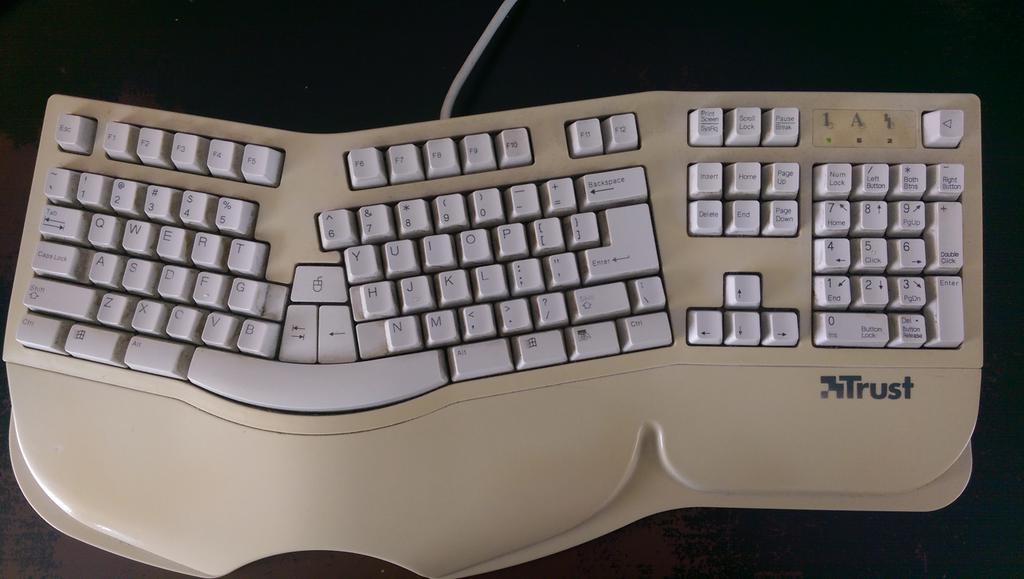
I loved it from the start even though it wasn’t quite as good as the Microsoft one I fell in love with during my placement. It also wasn’t particularly good quality and as I upgraded my PC over the next couple of years, I started to realise how keys were starting to stick and it was time to get another keyboard. So, what else was I to do? I was working as a graduate by then and thus had a bit more money to splash on a keyboard. So I bought the genuine article, albeit the latest version of it, the Microsoft Natural Elite:

Microsoft Natural Elite keyboard
It wasn’t quite as good as Microsoft’s original but way better than the Trust. This was my stalwart through most of the 2000s until one day, the right control key died suddenly. Yes, that’s it, I had lost control. (groan, ok, sorry – at least it wasn’t the Esc key or there’d had been no escape!!)
I’d no idea why it failed, I tried cleaning it, begging it, bashing it and swearing at it. Unsurprisingly, none of those things fixed it. Into the bin it went and my wrists and hands and well-established biases for Microsoft keyboards plus a desire to go for something a bit more slick and funky looking by then meant I just had to go for this, the Microsoft Comfort Curve 3000:
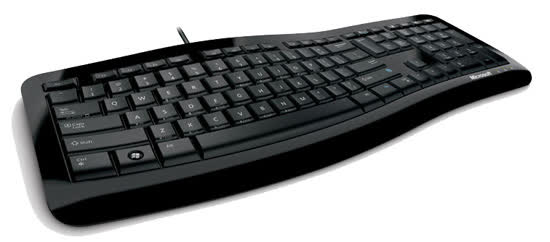
I hated this darn thing from the start! No, seriously, I did. Oddly I still have it lying around somewhere but I just hated using it. The keys were way too flat and unresponsive and it being merely gently curved – not split – just didn’t work for me. It was replaced less than a year later by this, the Microsoft Natural Ergonomic 4000:

Despite its slightly Dilbert-esq sounding name, it was a worthy replacement, though again, still not quite as good as the Elite (Microsoft, I think there’s a pattern here!) and that became my mainstay until 2014.
By this time Microsoft’s keyboards no longer seemed to have the reputation for quality they once had and I certainly had not been all that impressed by the 4000 given its rather high cost and relatively scrappy build quality, not even 2 years in it was starting to develop problems but I kept using it, albeit it now lived at work.
I wanted to get something else for home use and not pay a fortune for it. Happily, I came across the Perixx PERIBOARD-512 for a fraction of the price of Microsoft’s keyboards:

This has been a reliable workhorse, comfortable if rather clattery but nonetheless solidly reliable over 7 years. You can even still buy them today, a testament to a good design that’s been a best-seller and proven itself reliable “in the field”. Then last summer it started to get a bit sticky, the keys seemed a bit worn in places and no amount of cleaning it, lubing it and asking it nicely seemed to be helping. It was time to get a replacement.
And this, dear and patient reader, is where my troubles have truly begun.
I seemed to have forgotten the reason why I loved ergonomic keyboards in the first place, why I felt they were necessary and why I fell in love with one back in the 90s. I could have just bought another Perixx ‘512 but I wanted to go for something that was backlit as, though I don’t get much time to play it, as some of you may already know, I’m something of an Elite Dangerous fan and it’s so much nicer to play that in the dark and when you do, you really need a backlit keyboard (oh yes, you do!). So for all of these reasons and because backlit ergonomic keyboards are really hard to come by, I went for this, the Perixx PERIBOARD 324:
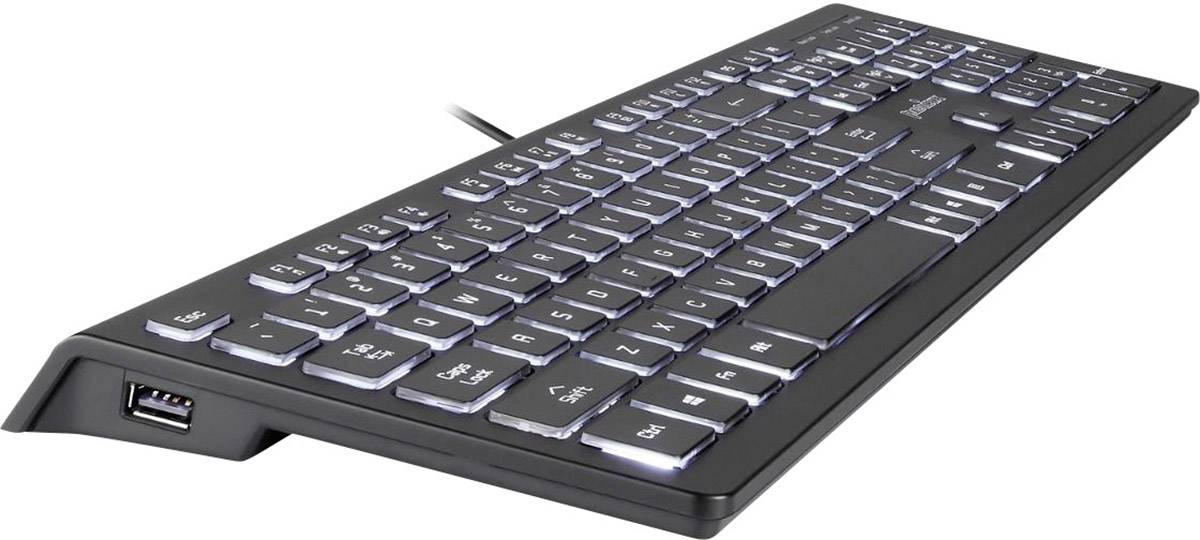
I really should have known but the combination of flat chiclet-style keys and its odd habit of having keys “bounce” resulting in keys registering twice ruled it out within days of receiving it. But I was still sold on the idea of a backlit keyboard and I was still forgetting about why I ever bought into ergonomic ones. So I went a bit upmarket and bought my first ever mechanical keyboard, the Lenovo Legion K500:
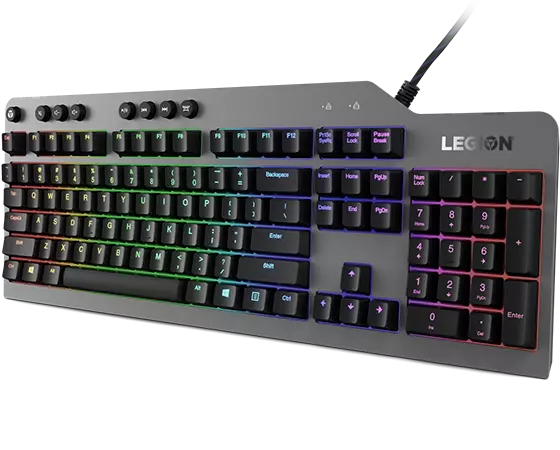
Now, this really looks the part. The keys feel really nice, though different as mechanical vs membrane is always quite a jump. But while I liked it and said “yup, that’s a keeper” there was something I was forgetting as I was celebrating this new keyboard last December.
And that something hit me, hard, about 4 weeks ago. I have indeed spent most of my life at a keyboad and of course, inevitably my hands have still suffered from wear and tear over all those years even though I’ve spent half of those years behind an ergonomic keyboard! Osteoarthritis is what it is, most of us who use keyboards extensively will get it, even if just a little. And boy, did it flare up suddenly. It didn’t take me long to realise that the relatively poorer typing position and harder strike required on the keys was causing my fingers to get inflamed or at least wasn’t helping me at a time like this. This keyboard had to go, sadly.
It was packed back into its box (where it remains still) and I finally bought what should be keyboard heaven for me. An ergonomic keyboard WITH A BACKLIGHT! Step forward, the Perixx PERIBOARD 330:

This thing looks wonderful (especially in the dark!). The front can be raised so the keyboard slopes backwards (as ergonomic keyboards truly should be but seldom are), it’s backlit and it has a built-in USB hub for plugging stuff in and a 4-way trackwheel. Surely this is keyboard perfection?
No, the keys absolutely suck! Yes it’s a chiclet-style keyboard and yes that’s going to mean it’s not as nice a traditional full-travel keyboard, but the keys are totally flat hard squares of hard to press down plastic. It’s like typing on scrabble tiles but much less comfortable! Some of the keys, like the T and N keys require you hit them dead on centre otherwise they don’t go down at all. They’ve not got even the slightest bit of indentation to them meaning your fingers slip and slide over and off them by mistake when you try to type fast. A fluid typing experience it is not by any means.
4 days. That’s how long that one lasted with me before being sent back. Everyone I showed that keyboard to at the university said it was awful. Some of my own friends said things about it I couldn’t even repeat here. To get 100% hatred on something like a keyboard really takes some doing eh?!
So I’ve just bought something else, and this, while not being backlit (that dream seems to have bit the dust now) is at least an ergonomic keyboard, the Cherry KC 4500 Ergo:
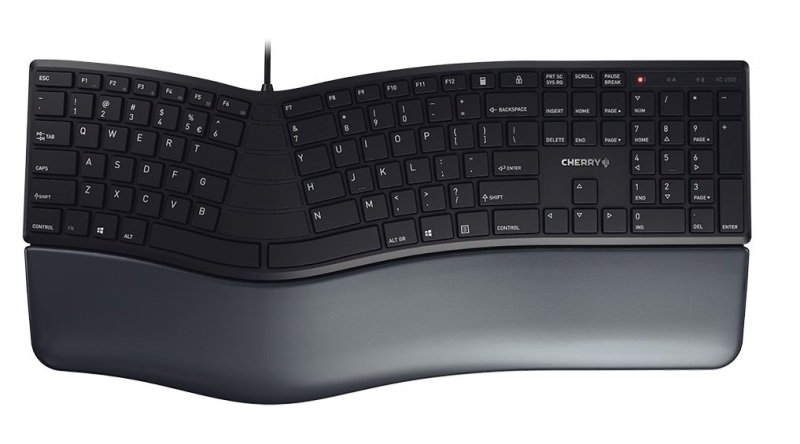
This is of significantly better quality and feel than the Perixx ‘330 but still, it’s not amazing.
The keys are also flat, chiclet and without any indentation whatsoever but at least are a little easier to press and the travel of the keys is softer and with a little more feeling than the Perixx. But some of the keys are crowded together and it’s very easy to hit the wrong key or get your fingers in the wrong place as some of the keys are weirdly shaped and smaller than expected.
In short: arrrggghhh, bloomin’ heck, not again!
I’m evaluating this keyboard now given it has a 14 day “no questions asked” returns window (I’m currently on day 6!) but I’m not sure about keeping it really already. It’s much harder to type on than the Perixx ‘512 even if the palm rest is rather soothing for my wrists as I type this, which is probably the weirdest piece I’ll likely ever write for this site!
Why can’t someone just make a proper (i.e. not form-over-function chiclet) keyboard with proper backlit keys in an ergonomic format? There must be a market for it. Or maybe there’s one I just haven’t found yet. It must have a £ on the 3 key (this is the UK, don’t you know!), must be backlit and must be ergonomic. Shall I keep looking or just give up and buy another Perixx ‘512?!
So, two lessons learnt here:
- Finding a decent ergonomic keyboard is something of a challenge these days; and
- You really should try to find one, look after your wrists and hands and they’ll look after you!
Seriously, really do. Make sure you do get time away from the keyboard and look after your hands, you’ll miss them when they’ve gone! I’d still recommend you look into an ergonomic keyboard of any make, despite my troubles here. Your wrists will thank you for it later regardless of whichever one you go for.
Now, does anyone want to buy a 3-month-old Legion K500 gaming keyboard, hmm?.. please get in touch! 😉
And as for me, if you can suggest a good one, with a backlight, the comments section below is for you! I think I still need a new “tyre”…
8th April 2022 update: After 10 days of using it, I gave up on the Cherry KC 4500 and returned it for a refund. It was too uncomfortable to type on in the end, some of the keys were too small/oddly placed and the feel of the keys just wasn’t right. I’m okay with a chiclet keyboard (heck, I’ve got a modern ThinkPad laptop with easily the finest chiclet keyboard of any laptop IMHO) but this was just not good enough.
I’ve just ordered something else though (it’s very odd-looking but sadly is sans-backlight still!) and will come back to this in a few days and say and show you what it is…
28th April 2022 update: So that replacement arrived a few days later and it’s this, the Lenovo Go Wireless Split Keyboard:
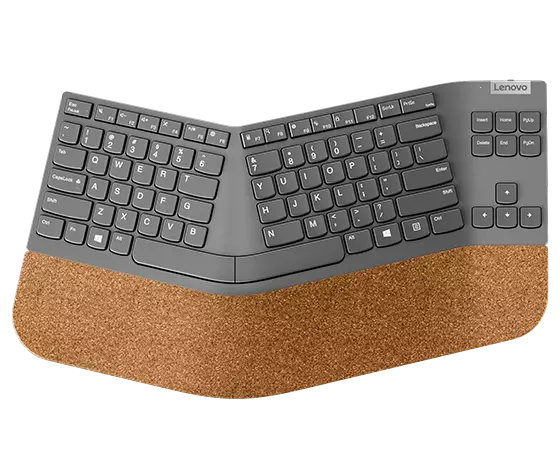
Now, this is significantly better, the keys are slightly scalloped and better spaced making it much nicer to type on, but still not a patch on a full-travel keyboard as it’s still a chiclet type. A little flawed though it still is, it’s pretty similar in feel to that of the modern Lenovo ThinkPads, even if that actual real cork wristrest worries me as I think one day one of my cats will realise it’s an ideal scratching mat! And, that wristrest could be more comfortable, for cork, it’s pretty hard really!

Given that it’s cost me a small fortune (relatively speaking – though University of Bolton staff and students thankfully get a 20% discount from Lenovo!) for both it and the optional wireless numeric keyboard, I’m going to have to get used to it over time – I can’t send this one back, but I don’t think I’ll be needing to, I’ll be alright…
I hope!
8th May 2024 update:
The Lenovo Go lasted me two years before I finally decided to replace it with something else! Before I explain what I replaced it with, let’s look at what I considered “wrong” with the Lenovo Go…
Firstly, the keys are chiclet-style. Ok, lots of keyboards are chiclet these days, apparently even desktop PCs are meant to have laptop-style chiclet keyboards: fashion is all important it seems!
But for my hands, the very short nature of the keys’ travel and the sudden stop that results, hurt my fingers just a bit too much when used regularly. Also, the layout of the keys has just oddly too much space between each key and it always felt weird to type on because of that and the short travel of the keys.
So screw fashion then! 😁
Plus, there’s the secondary issue that this was never backlit and that’s really what I wanted from the start. But I had exhausted all possible backlit, ergonomic keyboards, right?
Wrong!
It’s either coincidence or Perixx must have read this post 2 years ago (I sent it to them back then!) and took note of my plea for someone to make an ergonomic, backlit, non-chiclet keyboard as last year, they launched the PERIBOARD 835:

This isn’t just ergonomic and backlit, no, it’s also mechanical and wireless (or wired also if you prefer). You can choose from three different kinds of key switches: clicky blue, silent linear red or silent tactile brown. So this quite literally has everything I could want in a keyboard!
So I bought one straight away then? Sadly no, they didn’t make a UK layout version and I’ve been waiting for them to produce one since!
And now they have! I bought one 2 weeks ago (with the brown tactile switches) and it’s such a nice thing to type on, it’s great! At £170, it’s the most expensive keyboard I’ve ever bought!
So it’s perfection in keyboard form then? Not quite!
There are two things I’m not keen on with it. The first is that the wrist rest is a bit short and could have done with being a little deeper as your wrist doesn’t fully rest on it, just south of it instead. The second thing is that the function keys are only partially backlit in that the shortcut icons on the keys are backlit but the F1…F12 themselves are not. So in a dark room, you can see which keys control the backlight brightness or media player but you can’t see which key is which actual function key! I’ve already told Perixx about this and hopefully, they’ll improve it for a future version of this keyboard!
But otherwise, so pleased am I with this keyboard, I’ve just bought the cheaper non-wireless, non-backlit version of it, the PERIBOARD 535, for use on my work PC and this should feel the same as this ‘835.
So at last, my keyboard search is over, finally!
Never tried ergos before, but if I was in your shoes I’ ll probably go for the Perixx ‘512 again. Seems like companies are mistaking ergonomic with “design”, and flat keys are the “fashion”.
I am lucky to have a keyboard I love, but it is not backlight either…. Well, a lamp also lives on my desk now, which also works if I need to take a quick note, or read something while I wait for something heavy to compile. Good keys are at least four times more important than backlight, trust!
Yup good points and I’m largely in agreement with you, except that the ‘512 doesn’t slop backwards and that is a really useful thing to have. Yes I could just wedge something under it but that’s a kludge that will move around and not stay put. Maybe some glue is needed.. hmm.. Anyway, I’m day 7 with the Cherry and still undecided…
Having tried various keyboards including ergonomic the best I’ve used has to be the original IBM PS/2 keyboard and for those not old enough it’s not a PlayStation
Yup, that would be the IBM model M IIRC, I think they are one and the same thing, just the early model Ms had a large 5-pin DIN plug, and later they had the PS/2 plug. But yes indeed they were awesome keyboards and a variant of them is still available today!